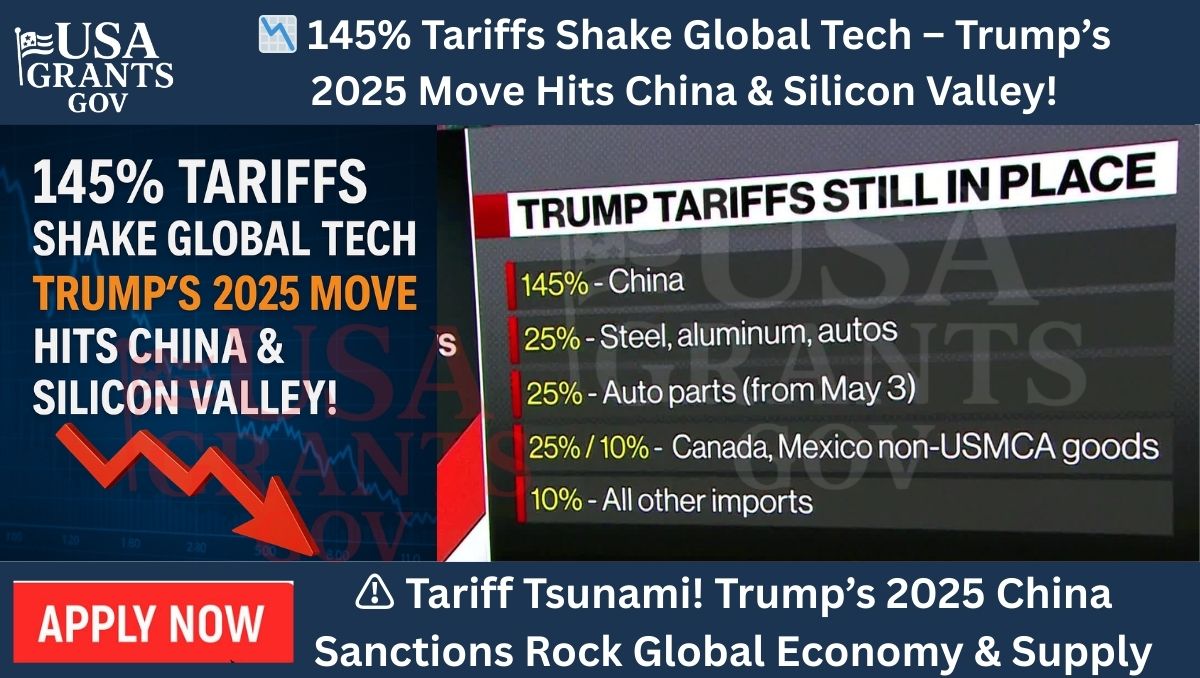Trump’s 2025 tariffs In April 2025, President Trump imposed tariffs on many countries, the highest of which was imposed on China, which is 145 percent. This has caused great damage to the entire world economy, and the technology sector in particular has been hit even harder. This has affected electronics and other things in many ways.
Visit more:https://www.usa.gov/
Trump’s 2025 tariffs Understand the tariff breakdown
New tariffs and some clauses
The 10 percent baseline tariff, which is imposed on all imports, targets 125 percent of Chinese goods, the 20 percent is imposed due to concerns about financial sanctions and China’s role, and the 145 percent tariff aims to reduce imports of goods made in China and those made in the United States, including semiconductors, pharmaceuticals, and many other items.
📊 Trump’s 2025 Tariffs on China – Key Highlights Table
| Section | Summary |
|---|---|
| 📈 Tariff Announcement | In April 2025, Trump imposed tariffs up to 145% on Chinese goods. |
| 🔢 Tariff Breakdown | – 10% baseline on all imports – 125% on Chinese goods – 20% due to financial sanctions – 145% on semiconductors, pharma, and key items |
| 💻 Tech Sector Impact | Electronics and laptops are exempt, but other goods face tariffs. Companies like Apple, Nvidia, Google, Microsoft are affected. |
| 🇨🇳 China’s Response | China imposed a 34% tariff on U.S. goods and export restrictions, hurting American companies. |
| 📉 Market Reaction | Stock markets became volatile; tech stocks dropped, affecting investors. |
| 🏭 Domestic Manufacturing | U.S. pushes for local production. China moves manufacturing to other countries. |
| 🧾 Conclusion | Trade volume between U.S. and China dropped. Consumer prices rose. Supply chains disrupted. |
Trump’s 2025 tariffs Impact on the technology sector
The tax sector, which is heavily dependent on Chinese manufacturing, has faced many difficulties. Electronics, smartphones and the products that consume them, such as laptops, are currently exempt from any tariffs. All other products are subject to tariffs. This has had a huge impact on the price of these items. Chinese companies used to make semiconductors. These companies have suffered a lot, affecting companies like Apple and Nvidia.Which has affected many things from Amazon, Microsoft and Google
Trump’s 2025 tariffs retaliatory measures
In response, China has taken many steps, the first of which is to impose a 34 percent tariff on American goods, which has caused great damage to American goods. Export controllers protect manufacturing, and their exports have also been hit hard.Export controllers have hurt many exports for tech manufacturing. Companies doing work for the US inside China have also been hit hard.
Market reactions and economic impacts
This announcement has caused immediate volatility in the market. Due to the volatility of the stock market, the shares of many companies have been damaged, including those who invest and do business.
Long-term outlook
Hey, there is a huge practical part to encourage domestic manufacturing. Among the many measures, the US government is facilitating domestic production. Especially due to the supply chain damage for the semiconductor sector, Chinese companies are turning to other countries for their manufacturing to reduce their losses so that they can keep their losses to a minimum.
Conclusion
President Trump’s 2025 tariffs, which have a significant impact on the technology sector, have significantly reduced the volume of trade between the United States and China. The supply chain of domestically produced goods has also been hit hard, with rising consumer prices and market volatility. The global economy is watching closely as both countries navigate this complex economic landscape.
What are Trump’s 2025 tariffs on China?
In April 2025, President Trump imposed new tariffs on several countries, with the highest—145%—imposed on Chinese goods. These tariffs target a wide range of Chinese imports, especially in the tech and manufacturing sectors.
What is the breakdown of the new tariffs?
10% baseline tariff: Applied to all imports.
125% tariff: Targeted at specific Chinese goods.
20% tariff: Due to concerns about financial sanctions and China’s role in global trade.
145% tariff: Imposed to limit imports of key items such as semiconductors, pharmaceuticals, and tech products.
How has the tech sector been affected?
The technology sector, heavily reliant on Chinese manufacturing, has faced severe disruptions. While electronics like smartphones and laptops are currently exempt, other products have become more expensive. Companies like Apple, Nvidia, Amazon, Microsoft, and Google have been significantly impacted.
How are Chinese companies reacting to the tariffs?
Chinese manufacturers are exploring new markets and shifting operations to other countries to reduce losses and maintain business continuity. This is part of a broader effort to adapt to the shifting global trade environment.
Are there any exemptions in the tariffs?
Yes. Currently, smartphones, laptops, and similar consumer electronics are exempt from tariffs. However, most other tech components and manufactured goods are subject to the new taxes.
